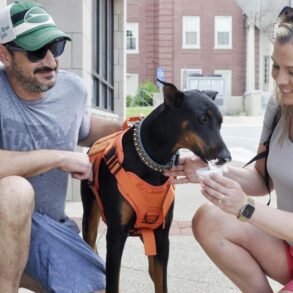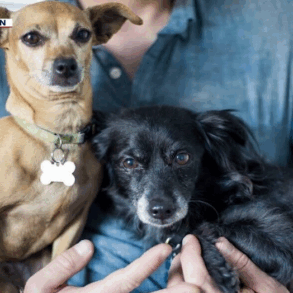
During the past year I’ve received numerous emails that can be best characterized as requests to “right the wrongs about prevailing myths about dogs and their relationships with us.” Among the various reasons I wrote Dogs Demystified: An A-to-Z Guide to All Things Canine was to do just that, yet I still read essays that perpetuate mistruths that simply do not portray who dogs truly are or why they do many of the things they do. Along these lines, Marie asked, “Can you please briefly summarize some of the common myths about dogs?”; Tomas wrote. “I am living with my first dog, Fergus, and much of what I read doesn’t portray Fergus as the individual he is and what moves him to do the things he does”; and Jackie—a renowned scientist—wrote, “I’ve lived with many dogs over the past 30 years and I’m baffled by books and articles that falsely claim such things as dogs don’t like to be hugged, dogs shouldn’t sleep in my bed, and dogs live in the moment as if past experiences and future expectation don’t play any role in what they’re thinking, feeling, and planning at any given moment.”
I agree with their and others’ concerns and confusion and frankly am incredulous that in some recent books and articles about dogs I still read falsehoods including utterly misleading generalities such as dogs are our best friends; they’re unconditional lovers; a wagging tail means they’re content and happy; and growling means they’re angry and pissed off.
Below, I list some myths that science and a dose of common sense clearly prove falsely represent and harm dogs, set false expectations for humans, and short-circuit the development of mutually beneficial symmetrical give-and-take relationships based on respect and trust.
Some myths about dogs based on what we know and don’t know
I also wrote my book to help people become fluent in dog—dog literate—and to offer a little-known fact is that an estimated 60-75% of the billion or so dogs on Earth are free-ranging or feral, so using “homed” dogs and dogs studied in laboratories to explain dog behavior can be misleading.1 Based on different peoples’ queries, here I simply want to gather an array of myths in a single place for the sake of convenience. (Detailed discussions and references for these and other myths can be found here and here.)
- Dogs are our best friends.
- Dogs are unconditional lovers.
- There is a universal, prototype dog.
- Dogs only need food and a warm safe bed and place to rest.
- Dogs don’t display dominance and there aren’t alpha dogs.
- Dogs don’t feel guilt.
- Dogs live in the present.
- Dogs don’t like to be hugged.
- Dogs shouldn’t sleep in bedrooms or beds.
- It’s okay to give dogs as gifts
- Dogs are trying to dominate us when we play tug-of-war.
- Peeing is always scent-marking.
- Dogs don’t dream.
- All dog parks are bad.
- Don’t feed them “people’ food
- Puppy mills are okay.
- Dogs know they or their friends—canine, feline, or human—are dying.
- Dogs bark excessively to bother us.
- Dogs mount another dog to dominate them.
- Dogs like being groomed.
- Neutering male dogs makes them less aggressive.2
Why myths can harm dogs and undermine our relationships with them
These and other myths can be disturbingly misleading because there is no “the dog” and no single dog-human relationship. There’s lots of variation among them—even dogs of the same litter, breed, or mix—so normalizing a highly diverse species is fraught with errors. It’s also harmful to normalize dog behavior because not only do individual personalities among these highly emotional beings play a major role in why dogs do what they do, but so too do our expectations about claims that when dogs do this it means this, and when dogs do that it means that.
Context—who a dog is, who they’re encountering, where the interaction is occurring, and who else is around—dog or human, for example—plays a major role in how a dog chooses to behave and what their actions mean. It’s also essential to consider if a dog feels trapped and can’t leave a given situation. There also are large individual personality differences among littermates and siblings. Dogs are a very diverse lot and simply put,there is no “universal dog” or canine mind; variation isn’t noise but rather important information that can be used to help them and us along.
Some key takeaways include:
- Oversimplified explanations of what makes dogs tick are very often misleading, and usually dogs pay the price for these misunderstandings.
- There’s a lot of variation in dogs’ personalities and there is no “universal” canine mind that can explain how dogs should or will behave.
- Being dog literate, perhaps especially for first-time dog guardians, can improve the relationship people have with their dogs.
- When we make the effort to listen to what dogs, as unique individuals, are telling us or asking of us, it’s a win-win situation.
All in all, when tales about dogs evolve into misleading memes that get humans to do certain things, the dogs, their humans, and dog-human relationships can suffer. While I don’t know of any formal studies of how humans’ misunderstanding of dogs have led to people giving up on their dogs and relinquishing them or abandoning them, this surely would be a valuable area of research.
When people say something like, “I don’t get it, I read or hear that dogs should do this or shouldn’t do that, but my dog doesn’t follow these rules and is doing fine.” I usually explain that there really aren’t many hard-and-fast explanations or rules of thumb and depending on the situation at hand there might be little about which to be overly concerned. But if something seems or feels highly unusual or “off” I gently suggest that seeking out a professional who can help both of them along would be the best thing to do.
This post was originally published on this site be sure to check out more of their content.













































